| |
|
Xiamen Oil Paintings, Wholesale Direct!
|
|
100% hand painted, 100% cotton canvas, 100% money back if not satisfaction. |
|
|
|
|
ART WORKS INDEX
A
B
C
D
E
F
G
H
I
J
K
L
M
N
O
P
Q
R
S
T
U
V
W
X
Y
Z
|
|
ARTISTS INDEX
A
B
C
D
E
F
G
H
I
J
K
L
M
N
O
P
Q
R
S
T
U
V
W
X
Y
Z
|
|
|
|
|
|
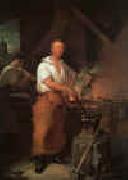 |
John Neagle
|
|
1796-1860
John Neagle Gallery
Neagle's training in art began with instruction from the drawing-master Pietro Ancora and an apprenticeship to Thomas Wilson, a well-connected painter of signs and coaches in Philadelphia. Wilson introduced him to the painters Bass Otis and Thomas Sully, and Neagle became a protege of the latter. In 1818 Neagle decided to concentrate exclusively on portraits, setting up shop as an independent master.
Aside from brief sojourns in Lexington, Kentucky, and New Orleans, Louisiana, he spent his career in Philadelphia. In May 1826 he married Sully's stepdaughter Mary, and for a time the son-in-law and father-in-law dominated the field of portraiture in the city. Neagle served as Director of the Pennsylvania Academy of Fine Arts, and was also a founder and president (1835-43) of the Artist's Fund Society of Philadelphia.
|
|
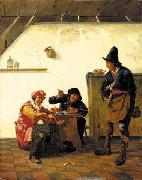 |
Johannes Natus
|
|
painted Peasants smoking and making music in an inn in 1660
|
|
|
|
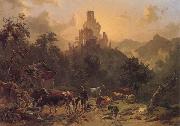 |
Johann Nepomuk Rauch
|
|
(1804 Vienna - 1847 Rome) was a very significant Austrian Biedermeier painter of the 1st half of the 19th century.
|
|
|
|
|
|
|
|
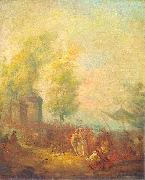 |
Jean-Pierre Norblin de La Gourdaine
|
|
(in Polish, Jan Piotr Norblin; 15 July 1745 - 23 February 1830) was a French-born painter, draughtsman, engraver, drawing artist and caricaturist. From 1774 to 1804 he resided in the Polish-Lithuanian Commonwealth, where he obtained citizenship.
He is considered one of the most important painters of the Polish Enlightenment. He achieved great success in Poland. Given many commissions from some of the most notable families of the Polish-Lithuanian Commonwealth, he stayed there for many years, not returning to Paris until the early 19th century. His style showed the influence of Antoine Watteau, and combined the Rococo tradition of charming fates galantes and fetes champetres with a panorama of daily life and current political events, captured with journalistic accuracy. He created a gallery of portraits of representatives of all social classes in the last years of the Polish-Lithuanian Commonwealth.
|
|
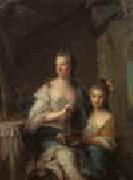 |
Jean Marc Nattier
|
|
1685-1766
French
Jean Marc Nattier Gallery
Brother of Jean-Baptiste Nattier. As well as being taught by his father, he trained with his godfather, Jean Jouvenet, and attended the drawing classes of the Academie Royale, where in 1700 he won the Premier Prix de Dessin. From around 1703 he worked on La Galerie du Palais du Luxembourg. The experience of copying the work of Rubens does not, however, seem to have had a liberating effect on his draughtsmanship, which was described by the 18th-century collector Pierre-Jean Mariette as cold. Nattier was commissioned to make further drawings for engravers in the early part of his career, including those after Hyacinthe Rigaud famous state portrait of Louis XIV (1701; Paris, Louvre) in 1710, which indicates that he had established a reputation while he was still quite young. Although he was offered a place at the Academie de France in Rome on the recommendation of Jouvenet, Nattier preferred to remain in Paris and further his career. In 1717 he nevertheless made a trip to Holland, where he painted portraits of Peter the Great and the Empress Catherine (St Petersburg, Hermitage). The Tsar offered Nattier work at the Russian court, but the artist declined the offer. He remained in Paris for the rest of his life.
|
|
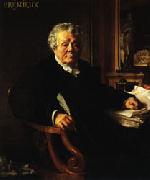 |
Jean Lecomte Du Nouy
|
|
French Painter and Sculptor, 1842-1923,was an orientalist French painter and sculptor. He was Charles Gleyre's and Jean-Leon G??rome's pupil. A Paris street was named after him in 1932.
|
|
|
|
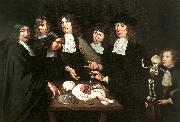 |
jan van neck
|
|
(1634-1714), was a Dutch Golden Age painter. Biography. He was born in Naarden and became a painter, draftsman, engraver, and interior
|
|
|
|
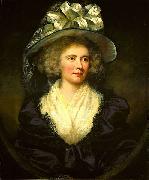 |
James Northcote
|
|
RA (22 October 1746 - 13 July 1831), was an English painter
was born at Plymouth, and was apprenticed to his father, a poor watchmaker. In his spare time, he drew and painted. In 1769 he left his father and set up as a portrait painter. Four years later he went to London and was admitted as a pupil into the studio and house of Sir Joshua Reynolds. At the same time he attended the Royal Academy schools.
In 1775 he left Reynolds, and about two years later, having made some money by portrait painting back in Devon, he went to study in Italy. On his return to England, three years later, he revisited his native county, then settled in London, where John Opie and Henry Fuseli were his rivals. He was elected associate of the Academy in 1786, and full academician in the following spring. The "Young Princes murdered in the Tower," his first important work on a historical subject, dates from 1786, and it was followed by the "Burial of the Princes in the Tower". Both paintings, along with seven others, were intended for Boydell's Shakespeare Gallery. The "Death of Wat Tyler", now in the Guildhall, London, was exhibited in 1787; and shortly afterwards Northcote began a set of ten subjects, entitled "The Modest Girl and the Wanton", which were completed and engraved in 1796. Among the productions of Northcote's later years are the "Entombment" and the "Agony in the Garden," besides many portraits, and several animal subjects, such as "Leopards", "Dog and Heron", and "Lion".
|
|
|
|
|
|
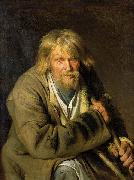 |
Ivan Nikolaevich Kramskoi
|
|
(June 8 (O.S. May 27), 1837 ?C April 6 (O.S. March 24), 1887; was a Russian painter and art critic. He was an intellectual leader of the Russian democratic art movement in 1860-1880.
Kramskoi came from a poor petty-bourgeois family. From 1857 to 1863 he studied at the St. Petersburg Academy of Arts; he reacted against academic art and was an initiator of the "revolt of fourteen" which ended with the expulsion from the Academy of a group of its graduates, who organized the Artel of Artists
Influenced by the ideas of the Russian revolutionary democrats, Kramskoi asserted the high public duty of the artist, principles of realism, and the moral substance and nationality of art. He became one of the main founders and ideologists of the Company of Itinerant Art Exhibitions (or Peredvizhniki). In 1863-1868 he taught at the drawing school of a society for the promotion of applied arts. He created a gallery of portraits of important Russian writers, scientists, artists and public figures (Lev Nikolaevich Tolstoy, 1873, Ivan Shishkin, 1873, Pavel Mikhailovich Tretyakov, 1876, Mikhail Saltykov-Shchedrin, 1879, Sergei Botkin, 1880) in which expressive simplicity of composition and clarity of depiction emphasize profound psychological elements of character. Kramskoi's democratic ideals found their brightest expression in his portraits of peasants, which portrayed a wealth of character-details in representatives of the common people.
In one of Kramskoi's most well known paintings, Christ in the Desert (1872, Tretyakov gallery), he continued Alexander Ivanov's humanistic tradition by treating a religious subject in moral Cphilosophical terms. He imbued his image of Christ with dramatic experiences in a deeply psychological and vital interpretation, evoking the idea of his heroic self-sacrifice.
Aspiring to expand the ideological expressiveness of his images, Kramskoi created art that existed on the cusp of portraiture and genre-painting ("Nekrasov during the period of 'Last songs,'" 1877-C78; "Unknown Woman," 1883; "Inconsolable grief," 1884; all in Tretyakov gallery). These paintings disclose their subjects' complex and sincere emotions, their personalities and fates. The democratic orientation of Kramskoi's art, his acute critical judgments about it, and his persistent quest for objective public criteria for the evaluation of art exerted an essential influence on the development of democratic art and aesthetics in Russia in the last third of the nineteenth century.
|
|
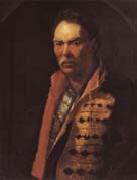 |
Ivan Nikitin
|
|
Russian Painter, ca.1680-1742,Russian painter. The son of a Moscow priest who was close to the imperial court, Nikitin probably studied at the workshop of the Armoury Palace in Moscow and subsequently worked chiefly in St Petersburg. His early portraits were of Peter the Great and members of Peter family, for example the portraits of Peter daughters Elizabeth (St Petersburg, Rus. Mus.) and Anne (Moscow, Tret yakov Gal.) and of his sister Natal ya Alekseyevna (St Petersburg, Rus. Mus.). One of the few signed and dated works is a portrait of Praskov ya Ioannovna, Daughter of Tsar Ivan V (1714; St Petersburg, Rus. Mus.). Nikitin style was formed at the time of Peter the Great reforms of the administrative and education system in Russia, and he ranks as a pioneer of a new style in Russian painting. In his early works, up to 1716, he adapted the medieval Russian style of portraiture to the forms of contemporary European examples.
|
|
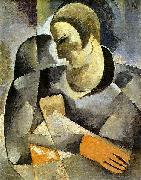 |
Ismael Nery
|
|
Ismael Nery (October 9, 1900 - April 6, 1934) was a Brazilian artist.
Born in Belem, Pare of Dutch, Native-Brazilian and African ancestry,[1] he studied at the Escola Nacional de Belas Artes (National School of Fine Arts) in Rio de Janeiro and at the Academie Julian in Paris. He created numerous paintings, wrote many poems and also helped design Brazil's National Patrimony of the Treasury department. Nery married a poet, Adalgisa Nery, in 1922. He contracted tuberculosis in 1931, and died of it in 1934.
|
|
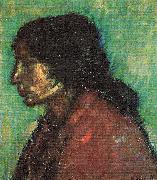 |
Isidre Nonell
|
|
(November 30, 1873, Barcelona, Spain - February 21, 1911, Barcelona) a Catalonian painter and drawer belonging to post-impressionism known for his expressive portrayal of the socially marginalized of Barcelona society. (He is also said to belong to modernism and postmodernism.)
Isidre Nonell was born in 1872 (not in 1873 as indicated by some biographers). His parents, Isidre Nonell i Torras de Arenys de Mar and Àngela Monturiol i Franc of Barcelona, owned a small but prosperous factory of soup noodles. Together with his childhood friend, Joaquim Mir, with whom he attended the same school in the neighborhood of Sant Pere in the old part of town in Barcelona, he developed artistic ambitions at an early age.
His early teachers included Josep Mirabent, Gabriel Martenez Alt and Llu Graner. From 1893 to 1895 he studied at the Escola de Belles Arts de Barcelona (Fine Arts School of Barcelona). He met Ricard Canals, Ramen Pichot, Juli Vallmitjana, Adrie Gual, and Joaquin Sunyer with whom he developed an interest in landscape painting, studying light. The study of sunlight and its effects on color were a main part of Impressionism, which was then active. They were called the "Saffron Group" for the warm tones they used, as well as the "Sant Marte Group" after the town they painted in.
In 1894, he began producing illustrations for La Vanguardia. He later drew for other periodicals, including LeEsquella de la Torratxa, Barcelona Cemica, Pel & Ploma, and Forma.
In 1896, Nonell went with Ricard Canals and Juli Vallmitjana to the spa town of Caldes de Boe in the Catalonian Pyrenees to work at the spa run by Vallmitjana's family. There, he saw a large number of people suffering from the illness of cretinism, which became a subject of his paintings.
In February 1897, he went to Paris with Ricard Canals. There he exhibited and shared a studio with Picasso. He returned to Barcelona in 1900. At the beginning of 1901, he made paintings of women, such as gypsy and working-class women, and still lifes. He exhibited in the Sala Par in Barcelona twice, in 1902 and 1903. The reaction to his works of poor gypsy women was very hostile.
|
|
|
|
|
|
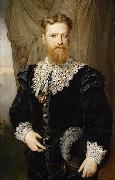 |
Hermann Nigg
|
|
painted Nigg Karl Lueger in historischem Kostum in 1876
|
|
|
|
|
|
|
|
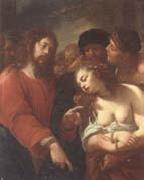 |
Giuseppe Nuvolone
|
|
Italian ,
b. 1619, Milano, d. 1703, Milano
was an Italian painter of the Baroque period, active mainly in Milan, Brescia, and Cremona. Born in San Gimignano. He was the brother of the painter Carlo Francesco Nuvolone and son and pupil of Panfilo. He painted St Dominic resurrecting the dead for the church of San Domenico in Cremona.
|
|
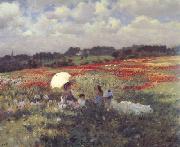 |
Giuseppe de nittis
|
|
Italian, 1846-1884
Italian painter, pastellist and printmaker. Throughout his career he was committed to a plein-air aesthetic and was particularly interested in rendering varying light effects, a concern that brought him into contact with the Impressionists. He was also acquainted with the members of the Macchiaioli, for whom his work was influential. In addition to oils, he experimented with printmaking and made innovative use of pastels. Practising a restrained, and therefore 'acceptable', form of Impressionism,
|
|
 |
Girolamo Nerli
|
|
1860-1926,was an Italian painter who worked and travelled in Australia and New Zealand in the late 19th century influencing Charles Conder and Frances Hodgkins and helping to move Australian and New Zealand art in new directions. His portrait of Robert Louis Stevenson in the Scottish National Portrait Gallery Edinburgh, is usually considered the most searching portrayal of the writer. Born in Siena in Italy to an Italian aristocrat, Ferdinando Pieri Nerli, his full name was Girolamo Pieri Pecci Ballati Nerli. The fourth of six children he was not a 'Marchese' as he was sometimes styled, or a 'Count', but a 'patrizio di Siena', a minor distinction marking the great antiquity of his family. His father married Henrietta Medwin, an Englishwoman. Her father Thomas Medwin was a minor literary figure in Byron's circle, the author of Journal of the Conversations of Lord Byron and of The Life of Percy Bysshe Shelley; Medwin was a distant relation of Shelley. Girolamo studied art in Florence under Antonio Ciseri and Giovanni Muzzioli and was a younger member of the Italian Macchiaioli school, the 'patch painters', an Italian movement anticipating French Impressionism. He went to Australia in 1885 spending time in Melbourne and Sydney where he was an associate of Tom Roberts and Arthur Streeton and an influence on Charles Conder at the time of the Heidelberg School. Nerli's role in that movement has been disputed but his presence and influence are undeniable. was an Italian painter who worked and travelled in Australia and New Zealand in the late 19th century influencing Charles Conder and Frances Hodgkins and helping to move Australian and New Zealand art in new directions. His portrait of Robert Louis Stevenson in the Scottish National Portrait Gallery Edinburgh, is usually considered the most searching portrayal of the writer. Born in Siena in Italy to an Italian aristocrat, Ferdinando Pieri Nerli, his full name was Girolamo Pieri Pecci Ballati Nerli. The fourth of six children he was not a 'Marchese' as he was sometimes styled, or a 'Count', but a 'patrizio di Siena', a minor distinction marking the great antiquity of his family. His father married Henrietta Medwin, an Englishwoman. Her father Thomas Medwin was a minor literary figure in Byron's circle, the author of Journal of the Conversations of Lord Byron and of The Life of Percy Bysshe Shelley; Medwin was a distant relation of Shelley. Girolamo studied art in Florence under Antonio Ciseri and Giovanni Muzzioli and was a younger member of the Italian Macchiaioli school, the 'patch painters', an Italian movement anticipating French Impressionism. He went to Australia in 1885 spending time in Melbourne and Sydney where he was an associate of Tom Roberts and Arthur Streeton and an influence on Charles Conder at the time of the Heidelberg School. Nerli's role in that movement has been disputed but his presence and influence are undeniable.
|
|
|
|
|
|
|
|
|
|
|
|
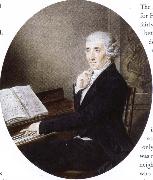 |
friedrich nietzsche
|
|
Period: Romantic (1820-1869)
Country: Germany
Born: October 15, 1844 in Röcken
Died: August 25, 1900 in Weimar
|
|
|
|
|
|
|
|
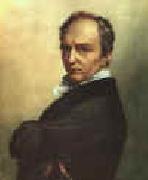 |
Francois Joseph Navez
|
|
1787-1869
French
Francois Joseph Navez gallery
Francois-Joseph Navez (Charleroi, 1787 - Brussels, 1869) was a Belgian neo-classical painter.
A pupil of Jacques-Louis David, he spent five years in Italy between 1817 and 1822.
He was a very successful portrait painter. He also painted many mythological and historic subjects.
The orientalist painter Jean-Francois Portaels was his pupil (and son-in-law).
|
|
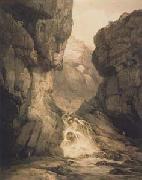 |
Francis Nicholson
|
|
English Painter, 1753-1844
English painter. After studying with a local artist in Scarborough, Nicholson began his career in his native Pickering, producing sporting pictures and portraits for Yorkshire patrons. In the mid-1780s a sideline in portraits of country houses led him to concentrate on landscapes in watercolour. From 1789 he contributed views of Yorkshire and Scotland to exhibitions at the Royal Academy. He also supplied topographical views for the Copper Plate Magazine. Although his market increasingly became London-based, Nicholson continued to live in Yorkshire (at Whitby, Knaresborough and Ripon), only moving to London c. 1803.
|
|
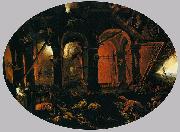 |
Filippo Napoletano
|
|
(c. 1587 - November 1629) was an Italian artist, with a peculiar output, mainly landscape and genre scenes and also drawings or etchings of diverse, often particular, items such as exotic soldiers, skeletons of animals, or cityscapes.
He began his career in his native city, Naples (1600-1613) and moved to Rome in 1614-1617), where he appears to have encountered and felt influenced by the successful Flemish landscape painters such as Paul Bril, Goffredo Wals, and Adam Elsheimer.
In 1617 Cosimo II dee Medici summoned him to Florence, where he worked closely with Jacques Callot. From notebooks, Filippo is known to have made hundreds of sketches of Tuscan landscapes and towns.
Starting in 1620 he reproduced in etchings part of his collection of animal skeletons owned by Johann Faber, a Bavarian physician-naturalist residing in Rome and a member of the scientific Accademia dei Lincei. In 1622, Napoletano published twelve etchings of caprices (capprici) and military uniforms (which he signed as signed Teodor Filippo de Liagno).
He is described by Giovanni Baglione as possessing a collection, a Wunderkammer of bellissime bizzarrie ("beautiful bizarre objects"), including among the objects exotic weaponry; fossilized plants; tiger, lion, and turtle skulls; oriental porcelain and sculpted crockery; a vest made of human skin; a harness for dragging whales on ice; a three-legged flea, Persian uniforms, and antiquities such as Roman coins, bronze lamps, and a few statuettes. After Napoletano death at Rome in 1628, bidding for such material was made by collectors such as Cardinal Ippolito Aldobrandini (future Clement VIII) and Cassiano dal Pozzo.
|
|
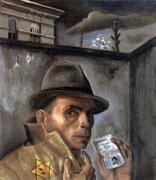 |
Felix Nussbaum
|
|
1904-44
Nussbaum was born in Osnabreck, Province of Hanover, as the son of Rahel and Phillip Nussbaum. Phillip was a World War I veteran and German patriot before the rise of the Nazis. He was an amateur painter when he was younger, but was forced to pursue other means of work for financial reasons. He therefore encouraged his son's artwork passionately. Nussbaum was a lifelong student, beginning his formal studies in 1920 in Hamburg and Berlin and continuing as long as the current political situation allowed him. In his earlier works, Felix was heavily influenced by Vincent Van Gogh and Henri Rousseau and he eventually pays homage to Giorgio de Chirico and Carlo Carre as well. Carl Hofer's expressionist paineng influenced Felix's careful approach color. In 1933, Nussbaum was studying on scholarship in Rome at the Berlin Academy of the Arts when the Nazis gained control of Germany.
|
|
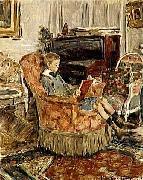 |
Etienne Moreau-Nelaton
|
|
Adolphe Etienne Auguste Moreau-Nelaton (2 December 1859, Paris- 25 April 1927, Paris) was a French painter, art collector and art historian. His large collection is today held in its entirety by National French museums.
Moreau-Nelaton's family's art collecting began with his grandfather Adolphe Moreau (1800-59). As a stockbroker he possessed ample capital with which to buy the work of artists with whom he was personally acquainted, including Eugene Delacroix and Alexandre-Gabriel Decamps. Moreau-Nelaton's father, who was also named Adolphe Moureau (1827-82), was a high government official and led the railroad company Chemins de fer de l'Est. In 1856 he married the ceramic artist Camille Nelaton (1840-97), with whom he further expanded the family's collection.
|
|
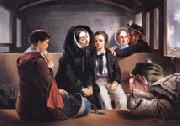 |
Erskine Nicol
|
|
British Genre Painter , (1825-1904)
was an Irish/Scottish painter. A student of William Allan, Nicol taught in Dublin, Ireland, from 1845-50, at the height of the Irish famine, and considered himself as much Irish as he was Scottish. Much of his work portrays the injustices inflicted upon the Irish population during the 19th century. He was made an Associate of the Royal Scottish Academy in 1855 and an Academician in 1859. Nicol exhibited at the Royal Academy and was made an Associate of the Royal Academy in 1866
|
|
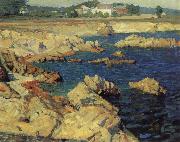 |
Ernest Bruce Nelson
|
|
American,a native of Northern California and a graduate of Stanford University
1888-1952
|
|
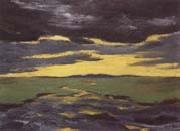 |
Emil Nolde
|
|
German Expressionist Painter, 1867-1956.German painter, watercolourist and printmaker. He was one of the strongest and most independent of the German Expressionists. Nolde belonged to the Dresden-based group known as DIE BR?CKE from 1906 to 1907. Primarily a colourist, he is best known for his paintings in oil, his watercolours and his graphic work. His art was deeply influenced by the stark natural beauty of his north German homeland, and alongside numerous landscapes, seascapes and flower paintings, Nolde also produced works with religious and imaginary subjects.
|
|
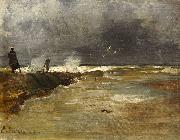 |
Emil Neumann
|
|
painted Strandspaziergang bei Wellengang in 1890
|
|
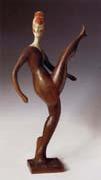 |
Elie Nadelman
|
|
Polish-born American Abstract Sculptor, 1882-1946,was an American sculptor, draughtsman and collector of Polish birth. Nadelman studied briefly in Warsaw and then visited Munich in 1902 where he became interested in Classical antiquities at the Glytothek. He lived in Paris from 1904 to 1914, closely involved with the avant-guarde, exhibiting at the Societe des Artistes Independants and at the Salon d'Automne from 1905 to 1908. His first solo exhibition in 1909 at the Galerie Druet, Paris, revealed a large series of plaster and bronze classical female heads and full-length standing nudes and mannered Cubist drawings; the latter purchased by Leo Stein, who had brought Picasso to Nadelman's studio in 1908. For the most detailed and accurate studies of Nadelman's work from 1905-12, which was of crucial importance for early 20th c. modern sculpture, see Athena T. Spear in Bibliography. He moved to the United States (becoming an American citizen in 1927) during the outbreak of World War I, married Mrs. Viola Flannery, a wealthy heiress,and assembled a large, museum quality collection of folk sculpture.
|
|
|
|
|
|
|
|
|
|
|
| Wholesale China Oil Painting Wholesale Oil Painting China Xiamen Portrait Reproduction on canvas Chinese Oil Painting Wholesale USA Oil Painting |
|
|
|
|
|